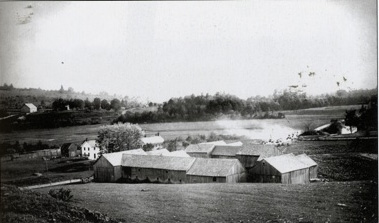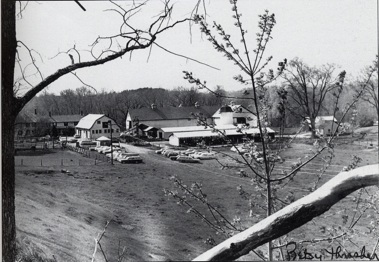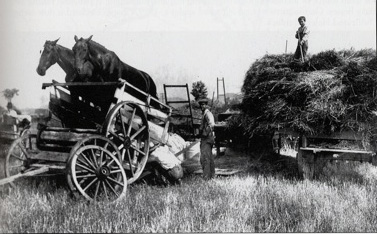
Vermont Barn Census
Chittenden County Student Research Project - 2010
Home
Survey Map
Historic Maps
Census
Pictures
VT Barn Census
Resources
An Agricultural History of Essex, VermontBy Constance Kent |
|||
The town of Essex, Vermont is located just north of the Winooski River in Chittenden County. The Browns River flows though the eastern portion of the town and both river valleys are covered in rich alluvial soil. This type of land is excellent for farming, and it was in these valleys that the first settlers to Essex made their homes. Essex was one of seven towns in Chittenden County chartered on June 7, 1763 by Benning Wentworth, the governor of New Hampshire. However, the first recorded settlement of the area was not until twenty years later in the spring of 1783. Samuel and William Smith, Jonathan Winchell, Dubartis Willard, and David Hall were the first settlers to the area and they settled in the previously mentioned Winooski and Browns River valleys.1 The following year brought an influx of settlers and the population of Essex rose steadily from then on.2 By the 1820s Essex was becoming well established agriculturally. In 1820 the town’s population was 1089, and in 1823 there were 282 horses and 1145 cattle in the town.3 There were also a gristmill, a fulling mill, and a carding machine, so one can infer that the town was also producing a fair amount of grain and wool.4 It should be noted here that Merino sheep were introduced to Vermont in the early nineteenth century, marking the beginning of the sheep boom, which lasted until the 1840s.5 As the century went on, farms grew larger as farmers transitioned from subsistence farming to more commercial pursuits. There are at least two recorded instances of farmers buying up multiple small farms to form larger establishments. Joshua Whitcomb, who purchased several smaller farms to acquire over 400 acres of farmland, founded the Green Meadow Farm at the intersection of Weed Road and Rt. 15 in 1848. Over the years he and his family built thirteen outbuildings across the road from their farmhouse as well as a cheese house attached to the back of the main house (Figure 1). The farm was one of the largest in Essex. It specialized in dairying and cheese making, but the family also produced maple syrup, bred Morgan horses, and had extensive vegetable gardens.6
Similarly, the Whitcomb Farm at the end of South Street in Essex Junction was comprised of five smaller farms. The Whitcomb Farm was founded in 1867 by Lorenzo Dow Whitcomb and is the only surviving dairy farm in the village of Essex Junction today (Figure 2).7
Through the mid-1800s farms continued the shift from small subsistence farms towards commercial operations. Not only did farms get larger, but they also became more specialized. Agricultural census records from the 1850s and ‘60s reveal that most farms at that time were raising and producing a wide variety of animals and crops. In 1850 it was not uncommon for one farm to have a few cows, a few horses, some sheep, and some pigs, while producing a variety of crops. However, by 1880 it is evident that many farms were transitioning to single purpose enterprises (mainly dairying). The 1880 census shows a fair number of farms that have several dairy cows and a few horses, but no other livestock.8 This movement towards dairying could be a result of an increased demand for cheese and butter. Although cheese and butter production were recorded on earlier censuses, the 1880 census shows the first census record of milk being shipped off of farms for butter and cheese production at creameries. Because of the increased popularity of sending milk to creameries to be turned into butter and cheese, the in-house cheese production rates dropped in 1880. However, the amount of butter produced on farms in 1880 was nearly double the amount produced in 1860 (220,000 lbs. in 1880 compared to 120,00 lbs. in 1860).9 Additionally, the railroad arrived in Essex Juncntion in 1849, enabling farmers to ship their products farther distances, and thus giving them a larger market than ever before. Apart from the increase in dairying in the later half of the nineteenth century, the two most significant trends in agriculture are the decrease in sheep production, and the disappearance of working oxen from farms. The dwindling numbers of sheep is not surprising, since the sheep boom reached its peak by 1840, after which time Vermonters found it difficult to compete with the more efficient sheep farming techniques in the western states. Sheep did not disappear entirely from the Essex agricultural record, but there was a clear decline in their numbers. More prominent than the decline of sheep was the decline of working oxen. In 1850 many farms had a team of oxen to do work around the farm. By 1880 there were only a few teams left, and more farms had horses to do the same work.10 Horses were easier to train and could do more versatile work than oxen. The development of Morgan horses in the nineteenth century could also have been a contributing factor to the switch. Both the Green Meadow Farm and the Chapin Farm were breeding Morgans in Essex (and possibly other farms, as well). Morgans were noted for their adaptability to working on Vermont farms (Figure 3).11
Dairying continued to be an agricultural staple through the twentieth century, but other crops have come and gone. The production of the Whitcomb Farm is a good indicator of local trends. From 1901 to 1959 they planted 75 acres of corn to sell to the H.C. Baxter and Brother corn-canning plant, which was running in Essex Junction at the same time.12 When Fort Ethan Allen was active in the first half of the twentieth century, the farm grew twenty acres of potatoes to feed the soldiers at the fort. Children used to be let out of school early to pick corn and potatoes for the Whitcombs.13 Although dairying continued to be a major theme in Essex agriculture through the twentieth and into the twenty first century, the small, diversified family farm never disappeared. Chapin Farm was owned by the same family for five generations, and is still operating as an apple orchard, although it is no longer owned by the Chapin family. Barbara Chapin remembers growing up on the farm and the variety of products they produced. The farms on Chapin Road mainly produced milk, but the Chapin Farm also had a cheese and butter room. In addition to dairying the farm raised pigs, eggs (although just for the family), bees, corn and apples, as well as logging some of their land. The Matthews farm, down the road would ship eggs to Hartford, Connecticut during World War II. Both farms produced maple syrup and would ship it as far as California.14 Today there are still many farms left in Essex, but there are also many that have not survived. The farmers, themselves, have said how difficult it’s becoming. Ed Whitcomb, the descendant of Lorenzo Dow Whitcomb, says, “It’s very, very competitive.” “You have to diversify to survive,” claims Judy Adams, another local farmer.15 This is an interesting statement given that 150 years ago farmers were moving towards more specification in their productions. 1 L.C. Butler, M.D., Essex Centennial: The One Hundredth Anniversary of the Settlement of Essex, Vermont (Montpelier, VT: Argus and Patriot Book and Job Printing House, 1883), 8. |
| Bibliography |
Allen, Richard and Lucille. Images of America: Essex and Essex Junction. Charleston, SC: Arcadia Pub., 2004 Beers, F.W. Atlas of Chittenden County Vermont. Rutland, VT: Charles E. Tuttle Company, 1971. (Original 1869) Bent, Frank R., ed. The History of the Town of Essex. Essex, VT: Essex Publishing Company, Inc., 1963. Butler, L.C. Essex Centennial: The One Hundredth Anniversary of the Settlement of Essex, Vermont. Montpelier, VT: Argus and Patriot Book and Job Printing House, 1883. Carlisle, Lilian Baker, ed. Look Around: Essex and Williston, Vermont. Burlington, VT: George Little Press, Inc., 1973 Chapin, Barbara. “The Farm as an Integral Part of the Community.” The ECHO Newsletter of the Essex Historical Society (Fall 1999). Clapp, George. “Gentes Family, The Name Behind the Road.” The ECHO Newsletter of the Essex Historical Society (Spring 2002). Clapp, George. “Green Meadow Farm.” The ECHO Newsletter of the Essex Historical Society (Fall 2000). Digennaro, Diane. “Tales from the Farm.” The ECHO Newsletter of the Essex Historical Society (Spring 1998). Fox, Gerald. “Browns River Cheese Factory.” The ECHO Newsletter of the Essex Historical Society (Spring 2008). Jordan, Laurie. “The Neighboring Farms of Chapin Road: Remembrances of Earle Matthews and Barbara Chapin, Part 1.” The ECHO Newsletter of the Essex Historical Society (Spring 2008). Jordan, Laurie. “The Neighboring Farms of Chapin Road: Remembrances of Earle Matthews and Barbara Chapin, Part 2.” The ECHO Newsletter of the Essex Historical Society (Fall 2008). Powell, Harriet Farnsworth. Yesterday in Essex. Essex Jct, VT: Essex Publishing Co., Inc., 1977. Russell, Howard S. A Long Deep Furrow: Three Centuries of Farming in New England. Hanover, NH: University Press of New England, 1976 Thompson, Zadock. A Gazetteer of the State of Vermont. Montpelier, VT: E.P. Walton, 1824. United States Bureau of the Census, Vermont Division of Public Records, Vermont Agricultural Census, 1850. United States Bureau of the Census, Vermont Division of Public Records, Vermont Agricultural Census, 1860. United States Bureau of the Census, Vermont Division of Public Records, Vermont Agricultural Census, 1870. United States Bureau of the Census, Vermont Division of Public Records, Vermont Agricultural Census,1880. Visser, Thomas Durant. Field Guide to New England Barns and Farm Buildings. Hanover, NH: University Press of New England, 1997. Wallings, H.F. Map of Chittenden County Vermont. Boston: Baker, Tilden and Co. Publishers, 1857.
|


